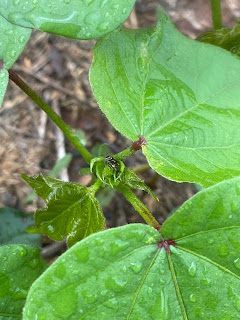Insect management is different from all other aspects of cotton production. With most insect pests, the situation changes year to year, week to week, and sometimes field to field. However, one insect that we can plan on being a consistent threat every year is thrips. This pest will infest 100% of the cotton planted in Alabama every year. What we cannot always predict, however, is when thrips pressure will peak. In a “normal” year in Alabama, we expect thrips pressure to be worse on early planted cotton and to be less later in the planting window as weather conditions improve. In 2021, this was not the case. Spring rains kept weedy hosts viable for a longer period, resulting in thrips pressure being the greatest on cotton planted after the middle of May. Much of our cotton was planted in this window and nearly 75% of our acres required a foliar treatment to supplement at-plant insecticides.
We have several options for at-plant management of thrips
including insecticide seed treatments, and in-furrow liquid or granular
materials. There are pro’s and cons of each approach, so deciding which
strategy to use may make sense for one situation and not for another.
At-Plant Insecticide
Options
Foliar
Insecticides
Foliar insecticides may be needed to supplement at-plant
treatments. However, foliar applications should never replace an at-plant
insecticide. Thrips can injure seedling cotton until around the 5th
true leaf stage. Research shows that foliar applications are usually most
effective when made at the 1st true leaf stage. The Thrips Infestation
Predictor for Cotton is a reliable tool that predicts the relative risk of
thrips injury for cotton planted at a given location and planting date. To maximize
the accuracy of the model, it should be run for several days before and after
planting, as unpredicted weather patterns may alter the prediction. This tool
should not be used to determine planting dates, but rather to help plan out
fields or planting dates for cotton that will likely need a supplemental foliar
application. Several options are available to use to supplement at-plant
insecticides.
·
Acephate (3 oz/A) is an effective and relatively
inexpensive option, however it has the potential to flare secondary pests such
as spider mites and is the least rainfast of the available recommended options.
·
Bidrin (3.2 oz/A) is another option that is
effective and less likely to flare spider mites and is more rainfast than
acephate, however it is more likely to cause crop injury when tank-mixed with
herbicides.
·
Dimethoate (6.4 oz/A) is another cost effective
and efficacious product with good rainfastness, however it is the most likely
to cause crop injury when tank-mixed with herbicides.
·
Intrepid Edge (3 oz/A) is another effective
option. Intrepid Edge is less likely to flare secondary pests but may need the
addition of a surfactant to help with efficacy.
·
Pyrethroids are not effective and should
not be used to manage thrips.
Effective thrips control is critical to get the 2022 crop off
to a good start. When considering areas to cutback on costs, do not skip out on
at-plant (IST or in-furrow) insecticides. We cannot manage thrips without
having protection for the seedlings as soon as they emerge. If planting into
cool, wet conditions, be prepared to make supplemental foliar sprays to help
seed treatments get seedlings to the 5th true leaf
stage. More information about thrips can be found in Pests of Alabama Cotton:
Thrips (ANR-2718).
For more information on thresholds and insecticide recommendations, visit the
Alabama Cotton IPM Guide (IPM-0415).
To stay up-to-date on the Alabama cotton insect situation, subscribe to the
Alabama Cotton Shorts Newsletter,
Alabama Crops Report Newsletter
and Podcast, and the Syngenta Pest Patrol Hotline.
.png)



